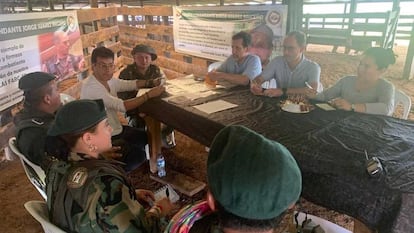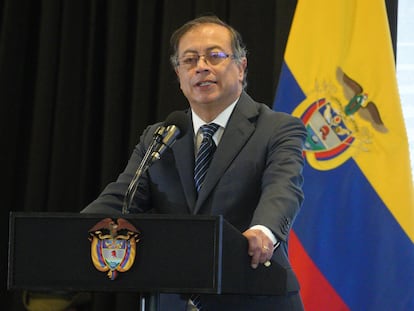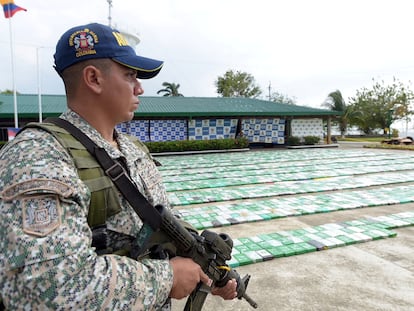A who’s who of the illegal armed groups in Colombia’s latest ceasefire
Guerrillas, militias and murky criminal organizations are all part of a complex negotiation by the Petro administration to bring about lasting peace


In a bold maneuver that might turn into a blunder, Colombian President Gustavo Petro’s announcement of a multilateral ceasefire with five very diverse armed groups has military officials and violence-wracked communities simultaneously perplexed and hopeful. Although it is being portrayed as an unprecedent breakthrough, negotiations of this type have been tried before at the height of the country’s war against drugs. Former presidents Belisario Betancur and Cesar Gaviria both initiated negotiations with multiple insurgent groups, and the latter even negotiated with the Medellín drug cartel, private militias and the Coordinadora Nacional Guerrillera (CNG), a group that sought to unite Colombia’s guerrilla factions. What’s different this time around, says political analyst Luis Fernando Trejos, is the number and diversity of the participating groups. “While we’ve had unilateral and bilateral ceasefires in the past, this is the first attempt at a multilateral ceasefire,” said Trejos. But that may be the biggest obstacle to success.
Below is a who’s who of the illegal armed groups participating in the Petro administration’s ceasefire negotiations.
The Gulf Clan
It’s known as the Gulf Clan or the Gaitanista Self-Defense Forces of Colombia, and it operates in the Gulf of Urabá region in the country’s northwest, a historical stronghold of paramilitary groups. The Gulf Clan burst onto the national stage when it paralyzed entire parts of northern Colombia for four days after the spectacular arrest and extradition of former leader, Dairo Antonio Úsuga (alias Otoniel). But their violent presence has long been felt by local communities in this part of the country. According to intelligence reports from the Duque administration, the Gulf Clan has an armed force of 1,200, and “is exclusively dedicated to the drug trafficking business.” Other reports place the number higher at 3,300 troops. The same intelligence report says that in late 2021, the Gulf Clan was seeking to expand into central Colombia. Before he was extradited to the United States, Otoniel testified that his group had ties to security forces and local politicians. Jesus Avila Villadiego (alias Chiquito Malo) then took over as boss of the Gulf Clan. Since Avila doesn’t seem to have much of a political background, it’s not clear if he’s leading the group’s negotiations with the Petro government.
The Gulf Clan is openly warring with rivals like the National Liberation Army (ELN) and the Sierra Nevada Self-Defense Forces. Analysts like Trejos and Reynell Badillo of the UNCaribe think tank say the Gulf Clan is not a traditional drug cartel, but more like a criminal conglomerate. “It’s more than a drug cartel. It manages a portfolio of illegal businesses,” said Trejos. Its diversification, urban presence and extortion activities may seriously challenge effective monitoring of the ceasefire. While some Gulf Clan members came from armed groups that were demobilized during the 2004 peace process, it should not be viewed as a successor paramilitary force. Trejos and Badillo agree that these forces will be key to demobilization in urban areas.
Sierra Nevada Self-Defense Forces
If the Gulf Clan is the most well-known group in the ceasefire negotiations, then the Sierra Nevada Self-Defense Forces are perhaps the least-known. This armed group has deep roots in the Sierra Nevada mountain range on the Atlantic coast. Unlike other groups, it’s a family clan linked to former paramilitary leader, Hernan Giraldo. It has been around for 40 years, and is the longest-lived organization in the negotiations, along with the ELN. Originally known as the Tayrona Resistance, it became the Caribbean arm of the Envigado sicario organization from Medellín. According to UNCaribe, the organization has only recently become politicized and now presents itself as a self-defense force.
The strength of the Sierra Nevada Self-Defense Forces is estimated at 150 permanent troops, a figure that does not account for all the people they hire for various criminal activities. They provide drug trafficking logistical services and transportation route protection, and are the biggest extortionists of businesses in the far northern Caribbean region of Colombia, which is why they are engaged in a bloody battle with the Gulf Clan for control of the Santa Marta port. Hernan Giraldo has sent letters from prison offering to mediate the negotiations, but the Petro administration may be unwilling to allow the participation of the convicted child rapist and paramilitary commander.
National Liberation Army (ELN)
Although it has denied agreeing to the ceasefire announced by the government, the ELN is actually the only armed group officially seated at the negotiating table. The ELN is the last active guerrilla force in the country after the FARC demobilization and had 2,350 combatants as of 2021 according to Colombian Army reports. It will be a key element in the ceasefire and ensuing humanitarian effort due to its heavy presence in the northeast (Catatumbo and Arauca) and the west (Nariño and Chocó).
An intelligence report issued in early 2022 by the Duque administration indicates that 60% of the ELN is funded by drug trafficking, and that it maintains a strong presence in Venezuela. “More than 1,100 members from various ELN units remain ensconced in several Venezuelan states… including three Central Command leaders, eight National Directorate leaders, 17 leaders of fronts, and 21 leaders of other units.”
The ELN has been a historically tough nut to crack at the negotiating table. This is the sixth time that a Colombian government has tried to demobilize the group, and the Petro administration is currently experiencing a critical period. One of the challenges in negotiating with the ELN is its federated structure, which means that some units may choose to disregard orders from leaders in Caracas. The government’s Special Jurisdiction for Peace (JEP) mechanism for the peace process has identified at least six ELN fronts that could derail the talks.
The Second Marquetalia
It was an event that shocked the nation. On August 29, 2019, Iván Márquez, former chief negotiator of the FARC, announced in a video that he was taking up arms again along with other former commanders such as Jesús Santrich. He named the new movement the Second Marquetalia, after the communist Marquetalia Republic guerrilla movement that battled the government for five years until it was defeated in 1964. Despite heavy criticism for dealing with a group that had renounced the peace process, Petro included the Second Marquetalia at the negotiating table.
According to the Fundación Ideas para la Paz (or, Ideas for Peace Foundation), this group “is still far from having the strength and capability of the former FARC. Although it seeks to evoke its FARC origins, it is more of an eclectic combination of armed factions that aspire to greater levels of autonomy, and seek funding and ideological support… The Second Marquetalia consists of Colombian and Venezuelan recruits with little training and political indoctrination.” According to the High Commissioner for Peace, Danilo Rueda, the group claims to have 1,500 armed troops.
Central General Staff
An offshoot of disaffected FARC leaders and soldiers that coalesced under the leadership of Miguel Botache Santillana (alias Gentil Duarte) and Néstor Fernández (alias Iván Mordisco), this group is now calling itself the Central General Staff. Even though Colombian authorities reported that Iván Mordisco had been killed in July 2022, he reappeared in a video a few months later. The group is active in the southwestern department of Cauca and has cowed the surrounding communities by murdering a number of civilian leaders. During the Duque administration, the group was loosely referred to as the Residual Armed Groups (GAOR), but it has taken an increasingly political stance since Petro took office. “They change names and spout political ideology to portray themselves as the FARC-EP, but they are just criminal federations,” said Trejos. This group may represent the same risk that became a reality during the 2004 demobilization of the United Self-Defense Forces of Colombia, which was nothing more than a bunch of regional criminal federations that united under former paramilitary leader Carlos Castaño just to present a strong political front in the negotiations.
Sign up for our weekly newsletter to get more English-language news coverage from EL PAÍS USA Edition
Tu suscripción se está usando en otro dispositivo
¿Quieres añadir otro usuario a tu suscripción?
Si continúas leyendo en este dispositivo, no se podrá leer en el otro.
FlechaTu suscripción se está usando en otro dispositivo y solo puedes acceder a EL PAÍS desde un dispositivo a la vez.
Si quieres compartir tu cuenta, cambia tu suscripción a la modalidad Premium, así podrás añadir otro usuario. Cada uno accederá con su propia cuenta de email, lo que os permitirá personalizar vuestra experiencia en EL PAÍS.
¿Tienes una suscripción de empresa? Accede aquí para contratar más cuentas.
En el caso de no saber quién está usando tu cuenta, te recomendamos cambiar tu contraseña aquí.
Si decides continuar compartiendo tu cuenta, este mensaje se mostrará en tu dispositivo y en el de la otra persona que está usando tu cuenta de forma indefinida, afectando a tu experiencia de lectura. Puedes consultar aquí los términos y condiciones de la suscripción digital.
More information
Archived In
Últimas noticias
The new victims of the Republican war on Obamacare: Millions hit by soaring health insurance premiums
A country divided on migrant rights: Some US states expand protections while others restrict them
Venezuela authorizes the release of another 87 political prisoners
There is as much life left to discover on planet Earth as that which is already known
Most viewed
- David King, chemist: ‘There are scientists studying how to cool the planet; nobody should stop these experiments from happening’
- Reinhard Genzel, Nobel laureate in physics: ‘One-minute videos will never give you the truth’
- Oona Chaplin: ‘I told James Cameron that I was living in a treehouse and starting a permaculture project with a friend’
- Sinaloa Cartel war is taking its toll on Los Chapitos
- The Interoceanic Train, the Mexican alternative to the Panama Canal










































